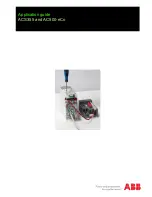
12 • 65-2331-04 H
2
S Transmitter
NOTE:
When first powered up, the transmitter will enter about a one minute period
when the 4-20 mA output is stabilizing and may be above the controller alarm
points or well below zero momentarily. RKI controllers have a one minute
warmup period when the controller does not display any gas reading or give any
alarm indication. The H
2
S transmitter’s 4-20 mA signal should be stable by the
time the controller’s warmup period is over.
CAUTION:
Allow the transmitter to warm up for 5 minutes before you continue with the next
section, “Setting the Zero Signal”.
Setting the Zero Signal
WARNING: Do not remove the detector housing cap or either of the junction box covers
while the circuits are energized unless the area is determined to be non-
hazardous. Keep the detector housing cap and junction box covers tightly
closed during operation.
NOTE:
If you can verify that the detector is in a fresh air environment (environment
known to be of normal oxygen content and free of toxic and combustible gases),
it is not necessary to apply zero air when verifying or setting the fresh air
reading.
The procedure below describes applying zero emission air, usually called zero air, using a
calibration kit that includes calibration gas, sample tubing, and a fixed flow regulator with
an on/off knob. RKI Instruments, Inc. recommends using a 0.5 LPM (liters per minute)
fixed flow regulator.
1.
Unscrew and remove the amplifier junction box’s cover from the junction box.
2.
Set a voltmeter to measure in the millivolt (mV) range.
3.
Plug the voltmeter leads into the test points on the amplifier. Plug the positive lead
into the red (+) test point; plug the negative lead into the black (-) test point.
4.
Screw the regulator into the zero air calibration cylinder.
5.
Use the flexible tubing coming from the calibration adapter/splash guard to connect
the regulator to the calibration cup.
6.
Turn the regulator’s on/off knob counterclockwise to open it. Gas will begin to flow.
7.
Allow the gas to flow for the length of time determined in “Determining Response
Time” on page 18.
8.
Verify a voltmeter reading of 100 mV (±2 mV).
9.
If necessary, use a small flat-blade screwdriver to adjust the zero pot until the
voltmeter reading is 100 mV (±2 mV).
10. Turn the regulator’s on/off knob clockwise to close it.
11. Disconnect the calibration adapter/splash guard’s flexible tubing from the regulator.
NOTE:
Do not disconnect the flexible tubing from the calibration adapter/splash guard.










































